When you hear the term “virtual reality,” what’s the first thing that comes to mind? For many, gaming jumps to the forefront — and fair enough: gaming was one of the first industries to embrace VR, and its popularity exploded in that space. But VR’s reach is expanding every day as innovators tap into the universe of experiences — and more importantly, positive changes — that this technology can bring to our lives.
Study after study confirms that virtual experiences can have measurable, long-term benefits for users, as well as those around them. It’s becoming increasingly clear that when it comes to virtual reality, the reality is this: from healing to teaching to strengthening human connections, VR is most impactful when it’s a vehicle for good.
In this article, we’ll dive into three of the fastest-growing areas where VR is already making a difference — and the emerging trends that will help us unlock its true potential.
1. Hands-On Learning
Educators can leverage virtual reality to teach in more immersive and effective ways.
Think back to your most memorable learning experiences; odds are, they involved more than reading a textbook or listening to a lecture. The most effective learning takes place when multiple senses are engaged, and when the learner plays an active role — and these are precisely the qualities that make VR a game-changing educational tool. Studies show that because it activates more parts of the brain than traditional teaching methods, VR can increase comprehension and retention levels by up to 35%.
Educational VR is rapidly making its way into schools and homes. Companies like Filter’s client, FishyTale, are enhancing academic and social learning by sending children on thrilling, funny, and interactive adventures. TheAstonishing Adventures of Little Lyle, for example, teaches kids about bullying and self-confidence through a story of a boy who’s teased about his height.
Across a widening range of subjects and grade levels, educators are using VR to transform passive lessons into immersive, hands-on experiences. From their desks, students can leap from the textbook to the “real thing” — whether it’s chatting with a historical figure, exploring a world-famous museum, or floating in space.
One exciting trend in this space is designing VR experiences for children with special needs. A number of new products are helping students with learning disabilities improve focus, social cognition and other skills so that they can function more successfully both in and out of the classroom.
On the horizon: Leveling the playing field
This technology could be especially beneficial in schools where large class sizes, overstretched teachers, and limited resources can affect students’ ability to learn and thrive. Because VR provides a high level of one-to-one engagement — and the freedom to go virtually anywhere — it could be a powerful way to equalize the educational landscape.
When it comes to putting educational VR to work, however, accessibility remains a major issue. As with any emerging technology, VR is equipment is expensive; though it will become more affordable in the coming years, it’s currently out of reach for many classrooms.
To explore this issue, we reached out to VR leader Eva Hoerth, one of 2016’s top 20 industry influencers. Eva got her start in VR working with Tom Furness, the “grandfather of VR” and a pioneering advocate of VR for Good. Since then, she’s been passionate about helping a wider population access these empowering tools. “We need to make sure that underserved students and communities get to learn about and experience virtual reality,” she explains. “This technology could be a huge equalizer — but first, we need to level the playing field in terms of accessibility.”
2. Healthier, Happier People
VR is already improving how people heal, both physically and mentally.
Picture yourself in a winter wonderland, floating down an icy river and dodging snowballs from playful snowmen. Feeling cold yet? That’s the point. Because this isn’t just a game: it’s SnowWorld, a VR experience designed to relieve pain in burn victims.
SnowWorld was one of the first virtual experiences that captured Eva’s attention, and it’s a perfect example of how VR can help alleviate discomfort and anxiety. By mentally transporting users to a chilly setting, this tool reduces burn victims’ pain by 40% — 50% (that’s as effective as morphine!).
VR’s healthcare applications are expanding quickly, from speeding up rehabilitation to training surgeons for complex procedures. Research indicates that virtual experiences can help treat psychological issues as well as physical ones: a recent study, for example, found that VR alone worked as well as a combination of drugs and VR therapy for veterans suffering from PTSD.
On the horizon: Mitigating potential risks
At this point, it’s clear that VR can have significant health benefits. However, because this technology is so new, there’s a lot we don’t know about its potential risks and long-term effects.
Some studies indicate that overexposure to virtual reality may generate its own trauma. In an interview in USA Today, Jeremy Bailson, the founding director Stanford’s VR lab, explains: “The truth is we don’t know what VR does to the brain yet, in part because the best brain studies require MRIs where the head needs to be still, and that’s not happening with VR.” Bailson says it’s typical to feel somewhat ill after being deprived of real-world stimuli for long periods; he never wears a headset for more than 20 minutes at a time.
Research is underway to address questions like whether VR causes excessive eye strain, and whether it could have any harmful impacts on children’s brain development. As the answers surface, healthcare VR will be able to achieve more widespread (and healthy) user adoption.
3. Building empathy and connection
VR breaks down the barriers that can separate us in real life, enabling people to connect in new ways.
Imagine experiencing the world as another gender, ethnicity, age, or socioeconomic position; VR is the closest humans have gotten to that ability. With its ability to immerse the user in a different perspective, VR is emerging as a powerful way to build empathy and fight prejudice. “Walking a mile in someone else’s shoes” is no longer a cliche; with virtual reality, it can become a life-changing experience.
Life-changing — really? Yep: research indicates that even after the headset comes off, users experience a real-life increase in empathetic feelings and behaviors. As Furness puts it, “When you put people into a place, you put that place into people.”
One poignant example is Clouds Over Sidra, a VR mini-documentary created by the UN, in which a 12-year-old girl introduces the viewer to her life in a Syrian refugee camp. A 2015 fundraising conference that showed the film raised $3.8 billion, 70% more than expected; people who watched it pledged donations at twice the normal rate.
One of the industry’s fastest-growing areas, social VR, is already transforming how we build relationships and communities. The ability to bring users together in a virtual setting has made social VR a popular feature for gamers — but its implications are much broader. For users around the world, VR could be a space to connect, collaborate, and empathize with people they wouldn’t meet in “real life.”
On the horizon: Making VR an inclusive space
VR opens up infinite possibilities for new social interactions — but unfortunately, not all of them are positive ones. The sense of anonymity VR can provide, combined with a lack of standardized enforcement, gives bad apples a chance to act inappropriately.
As a result, some VR spaces can feel unwelcoming or even unsafe; female users have been particularly affected. Virtual discrimination and harassment are real problems: as Eva explains in a recent article about sexual harassment in VR, “When you get up in someone’s ‘bubble’ in VR, you really feel like that’s happening.”
There’s good news on this front: people of all genders are fighting to make virtual spaces more diverse and inclusive. As women and minorities make up more of the VR industry (as both creators and consumers), we’re discovering ways to leverage VR as a vehicle for social empowerment. Take, for example, this “game” created by Variable Labs that helps women practice salary negotiation.
Eva is an organizer of Women in VR, and writes extensively about overcoming sexism in the industry. She explains that if there’s one key to solving these problems, it’s greater inclusion: “VR is going to succeed if we tackle these big questions early on, and invite voices beyond our industry to create with us. So let’s make it happen!”
Today’s impacts are just the beginning.
When it comes to using virtual reality as a vehicle for positive change, we’re only scratching the surface. The visionaries driving the industry are digging deeper every day, uncovering the opportunities (and challenges) that will determine the future of VR — and that will impact the lives of individuals and communities around the world. So keep an eye on VR for Good — because the best is yet to come.







